
Nepenthes spathulata is a tropical pitcher plant native to Java and Sumatra, where it grows at elevations of between 1100 and 2900 m above sea level. The specific epithet spathulata is derived from the Latin word spathulatus, meaning "spatula shaped", and refers to the shape of the lamina.

Nepenthes aristolochioides is a tropical pitcher plant endemic to Sumatra, where it grows at elevations of 1800–2500 m above sea level. It has an extremely unusual pitcher morphology, having an almost vertical opening to its traps. It is critically endangered by overcollection.
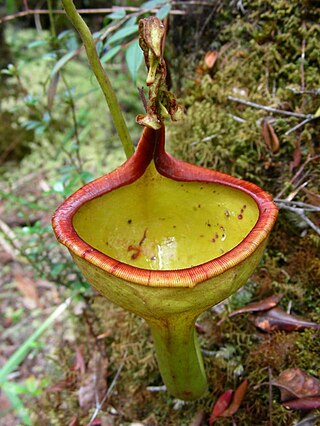
Nepenthes eymae is a tropical pitcher plant endemic to Sulawesi in Indonesia, where it grows at elevations of 1,000–2,000 m (3,300–6,600 ft) above sea level. It is very closely related to N. maxima, from which it differs in its wine glass-shaped upper pitchers.
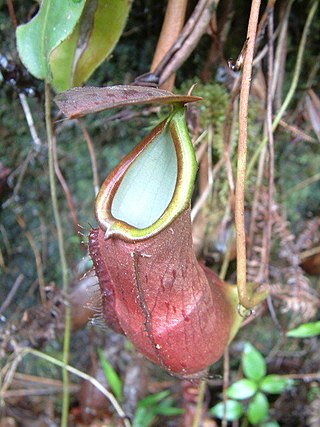
Nepenthes longifolia is a tropical pitcher plant endemic to Sumatra, where it grows at elevations of between 300 and 1100 m above sea level. The specific epithet longifolia, formed from the Latin words longus (long) and folius (leaf), refers to the exceptionally large leaves of this species.

Nepenthes jacquelineae is a tropical pitcher plant endemic to the Indonesian island of Sumatra. Due to its unique pitcher morphology, it is considered to be one of the most spectacular Nepenthes species native to the island.

Nepenthes dubia is a tropical pitcher plant endemic to the Indonesian island of Sumatra, where it grows at an altitude of 1600–2700 m above sea level. The specific epithet dubia is the Latin word for "doubtful".
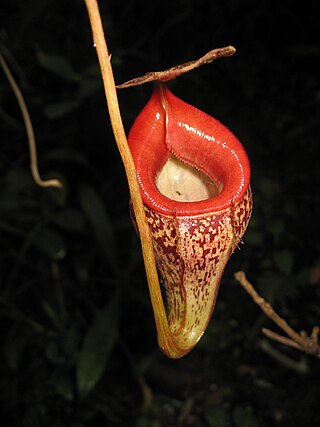
Nepenthes talangensis is a tropical pitcher plant endemic to Sumatra, where it grows in upper montane forest at elevations of 1800–2500 m above sea level.

Nepenthes tenuis is a tropical pitcher plant endemic to the Indonesian island of Sumatra. The species was first collected in 1957, from a remote mountain in the western part of the island. It remained undescribed until 1994, and was only rediscovered in the wild in 2002. Prior to this, N. tenuis was known solely from a single photograph and dried herbarium specimen.

Nepenthes rigidifolia is a critically endangered tropical pitcher plant endemic to Sumatra, where it grows at elevations of 1000–1600 m above sea level.
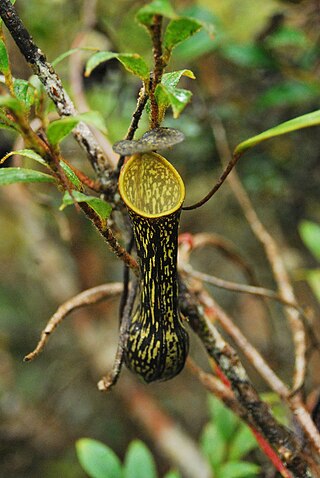
Nepenthes mikei is a tropical pitcher plant endemic to Sumatra. It is characterised by its black mottled lower and upper pitchers. The species is closely related to N. angasanensis and N. tobaica.
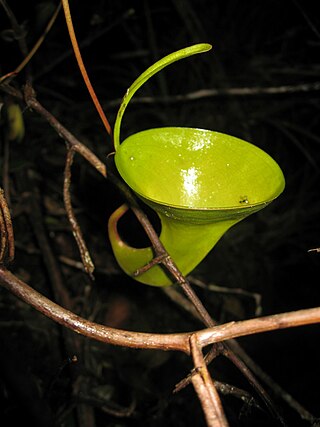
Nepenthes inermis is a tropical pitcher plant endemic to the Indonesian island of Sumatra. The specific epithet inermis is Latin for "unarmed" and refers to the upper pitchers of this species, which are unique in that they completely lack a peristome.

Nepenthes izumiae is a tropical pitcher plant endemic to Sumatra, where it grows in montane forest at 1700–1900 m above sea level. It appears to be most closely related to N. lingulata and N. singalana.

Nepenthes rhombicaulis is a tropical pitcher plant endemic to Sumatra. The specific epithet rhombicaulis is formed from the Latin words rhombicus, meaning "rhomboid", and caulis, "stem". It refers to the cross-sectional shape of the stem internodes.

Nepenthes ovata is a tropical pitcher plant endemic to Sumatra. The specific epithet ovata is Latin for "ovate" and refers to the shape of the lower pitchers.
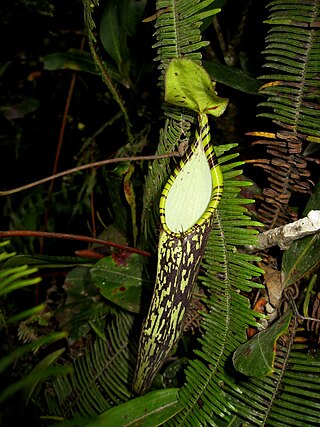
Nepenthes spectabilis is a tropical pitcher plant endemic to Sumatra, where it grows at elevations of between 1400 and 2200 m above sea level. The specific epithet spectabilis is Latin for "visible" or "notable".

Nepenthes lingulata is a tropical pitcher plant endemic to northern Sumatra. The species is characterised by the highly developed appendage present on the underside of the lid. The specific epithet lingulata is derived from the Latin word lingula, meaning "small tongue", and refers to this unique morphological feature.
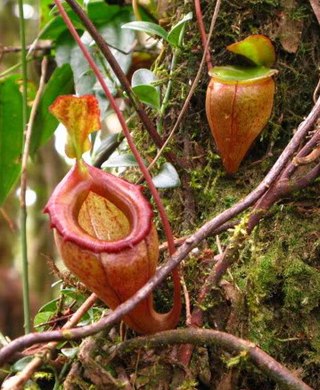
Nepenthes flava is a tropical pitcher plant endemic to northern Sumatra, where it grows in montane forest at 1800–2200 m above sea level.

Nepenthes naga is a tropical pitcher plant endemic to the Barisan Mountains of Sumatra. It is characterised by a forked sub-apical appendage on the underside of the lid and an undulate lid margin. The specific epithet naga is the Indonesian word for "dragon" and refers to the distinctive lid appendage of this species as well as the large size of its pitchers. The name also references local folklore, which tells of dragons occurring in this species's habitat in the past.

Nepenthes micramphora is a tropical pitcher plant known only from Mount Hamiguitan on the island of Mindanao in the Philippines. It is a highland plant growing at elevations of 1100–1635 m.

Nepenthes pitopangii is a tropical pitcher plant endemic to the Indonesian island of Sulawesi. Discovered in 2006, N. pitopangii was initially known from a single plant at a remote locality in Lore Lindu National Park. Efforts made in the following years to locate further populations on surrounding mountains proved unsuccessful. In March 2011, a new population of N. pitopangii consisting of around a dozen plants was discovered more than 100 km from the type locality. Nepenthes pitopangii appears to be closely related to N. glabrata, from which it differs most obviously in its upper pitcher morphology.





























